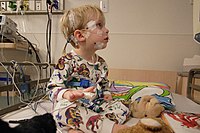
Photo from wikipedia
PurposeThe aim of this study was to describe the polysomnographic characteristics of adolescents with asthma who are at low risk for sleep-disordered breathing (SDB) based on the Pediatric Sleep Questionnaire… Click to show full abstract
PurposeThe aim of this study was to describe the polysomnographic characteristics of adolescents with asthma who are at low risk for sleep-disordered breathing (SDB) based on the Pediatric Sleep Questionnaire (PSQ).MethodsOvernight polysomnography was performed on 85 adolescents with asthma and a score < 0.33 on the PSQ. The Asthma Control Questionnaire was used to define “well-controlled” versus “inadequately controlled” asthma.ResultsMean age of participants was 14.5 ± 1.6 years (range, 11 to 17 years), 63.5% were girls, 57.6% were Caucasians, and the mean body mass index percentile was 65.1 ± 26.5. Asthma was well-controlled in 51.7% of the adolescents and inadequately controlled in 15.3%. Mean sleep efficiency (SE) was 88.0 ± 11.1%, and 24.7% had SE < 85%. Mean wakefulness after sleep onset (WASO) was 40.9 ± 44.0 min, and the mean arousal index was 10.8 ± 5.6 per hour. The mean apnea/hypopnea index (AHI) was 2.3 ± 4.2, and 29.4% of participants had SDB (defined by an AHI ≥ 2). Compared with normative values, adolescents with asthma had more nocturnal awakenings and WASO, and less REM sleep. SDB risk was higher in boys [odds ratio = 4.6 (confidence interval 1.4–14.7), p = 0.01]. Asthma control did not impact sleep and respiratory parameters, with no differences found between youth with well-controlled and inadequately controlled asthma.ConclusionsAdolescents with asthma are at increased risk of sleep-disordered breathing and suffer from disturbances in sleep continuity with more arousals and sleep fragmentation. Study results highlight the importance of proper screening for sleep-disordered breathing in adolescents with asthma.
Journal Title: Sleep and Breathing
Year Published: 2019
Link to full text (if available)
Share on Social Media: Sign Up to like & get
recommendations!